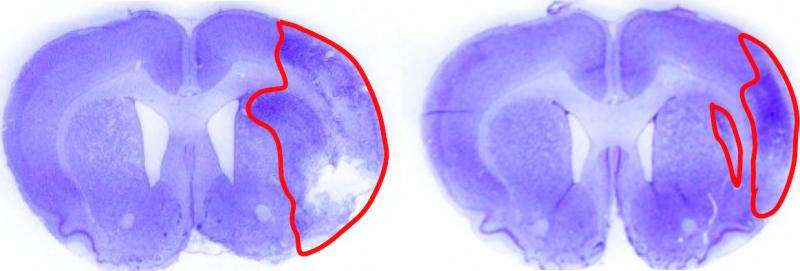Not 'junk' anymore: Obscure DNA has key role in stroke damage

A study of rats released today shows that blocking a type of RNA produced by what used to be called "junk DNA" can prevent a significant portion of the neural destruction that follows a stroke. The research points toward a future treatment for post-stroke damage, which is often more extensive than the initial destruction that results when blood to the brain is temporarily shut off.
The research also links two mysteries: Why does the majority of damage follow the restoration of blood supply? And what is the role of the vast majority of the human genome, which was once considered junk because it does not pattern for the RNA that makes proteins?
"Less than 2 percent of the RNAs formed from the genome code for proteins, leaving 98 percent that we call 'noncoding RNA,'" says senior author Raghu Vemuganti, a professor of neurological surgery at the University of Wisconsin-Madison.
In the study just published in the Journal of Neuroscience, Vemuganti and colleagues blocked one variety of long noncoding RNA (lncRNA), which exists in at least 40,000 unique varieties—possibly as many as 100,000.
"This lncRNA can bind to other RNA, to a protein, or to a protein on one side and DNA on the other," says first author Suresh Mehta, a scientist in the Department of Neurological Surgery. "Among many other jobs, lncRNAs can regulate gene activity."
"Stroke influences the expression of all types of RNA, and this RNA has a broad influence throughout the cell after the blood supply is restored, in what we call reperfusion injury" says Vemuganti. "A few years ago, our lab started to look at how stroke affects noncoding RNA. Two years ago, we identified about 200 types of various lncRNAs that greatly increase or decrease after stroke, and zeroed in on one that we named FosDT.
"We knew that the level of FosDT went up more than tenfold in the rat brain within three hours after the stroke," adds Vemuganti. "We thought, if we block FosDT after the stroke, would it make any difference in the amount of structural damage or behavioral disability?"
Vemuganti and his colleagues designed three custom-made strands of RNA to silence FosDT, injected them into the rats, and deliberately shut off one artery in the brain for one hour. Tests performed within the first week showed that the treated rats regained motor skills much faster and more completely than control animals. Brain scans showed a significant reduction in the total volume of brain that was destroyed by the stroke.
These studies were partially funded by the American Heart Association, National Institutes of Health, U.S. Department of Veterans Affairs and the Department of Neurological Surgery.
Further investigation showed that FosDT stimulates a pathway to cell death, while also impairing cell-survival pathways. Interfering with both mechanisms could explain the benefits, says Mehta.
"We did not change the initial insult, caused by lack of oxygen," says Vemuganti, "but this targeted approach greatly reduced the damage after one week. We cannot completely reverse the post-stroke damage, but the total damage decreased by one-third. If we can protect this much brain tissue from stroke, that would be an enormous improvement."
Because post-stroke damage (the "reperfusion injury") can be even more disabling than harm caused by the initial loss of blood flow, Vemuganti says he is pursuing several lines of research. "We are further exploring the mechanism, and we are preparing to see what happens after a stroke in rats that have no gene for FosDT."
Although rates of stroke have fallen in recent decades, about 795,000 Americans have a stroke each year, and stroke remains among the leading causes of disability.
"We intend to vigorously pursue this finding," Vemuganti said.


















